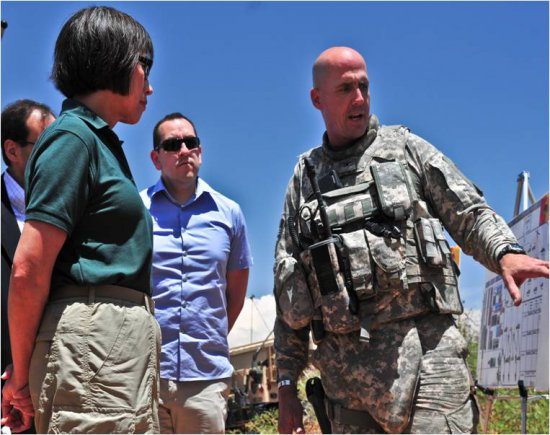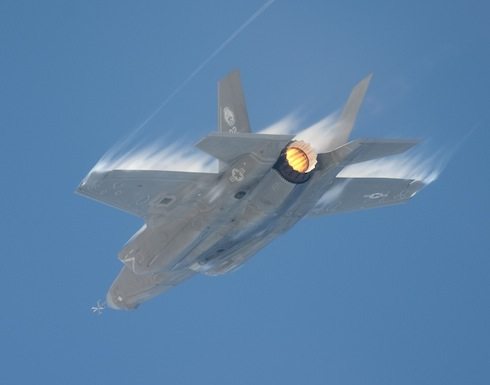Army Acquisition Executive Heidi Shyu praised the ongoing Network Integration Evaluation, known as the NIE, and stressed the importance of blending science and technology, or S&T, into the modernization strategy while meeting with program managers, Soldiers and service leaders May 11, at White Sands Missile Range, N.M.
“I am a huge proponent of the NIE. The next step is to more fully integrate the S&T community, so as to ensure that we are doing S&T that will be relevant to solving capability gaps,” Shyu said, while meeting with some of the key architects and executors of the NIE.
Shyu and Army NIE leaders discussed the importance of interoperability and battlefield communications in the broader context of needing to dominate the increasingly critical “information realm” of present and anticipated future conflicts; the NIE is designed to facilitate this kind of development of next-generation capability.
Synchronizing the Army’s S&T approach more fully with the NIE process and the service’s modernization efforts as whole, will allow the Army to identify and spiral in new technologies as they emerge with a mind to solving present and future challenges, Shyu explained; another key element of this is it will allow the Army to better keep pace with rapid technological change, at times aligning emerging capabilities with existing systems.
With this in mind, Shyu, who is also the acting assistant secretary of the Army for Acquisition, Logistics and Technology, talked about the importance of having a “near, mid and long” term S&T strategy, built upon an awareness of anticipated or potential threats; a key ingredient to success, she emphasized, is to build an awareness of potential threats into the acquisition process with a mind to identifying key systems, technologies and capabilities able to add great value to the force.
At the same time, a longer term S&T strategy is needed to help discover new capabilities in the “realm of the possible” and hopefully generate key, “leap-ahead” technologies, Shyu explained. “Looking out further, we want to synchronize what we are doing so as to best figure out the capabilities we will need for the future.”
Overall, the current 3,800 Solider-strong NIE, called 12.2, is placing three systems under formal tests and evaluating as many as 36 different emerging technologies; the idea is to perform needed integration and assessments of potential systems before they are fielded and, while benefiting from real-time feedback from Soldiers with operational experience in a realistic, combat-like scenario, identify and harness key capabilities.
As part of the NIE, Soldiers participate in mock-combat exercises in which U.S. Army forces are pitted against an extremely sophisticated, capable hybrid-type adversary, called the opposition force, or OPFOR. The networking technologies are spread across an area larger than 200 square kilometers in which, in this exercise, the fictional country of “Ellis” sent a hybrid-type hostile force on an incursion into neighboring “Attica.”
In the scenario U.S. and coalition forces were called upon to assist Attica in their effort to repel the incursion, which consisted of conventional and hybrid-type forces along with insurgent, terrorist and criminal elements.
As part of her discussion with NIE leaders, Shyu said the interactive process afforded by the NIE wherein Soldiers provide feedback, adds great value to the acquisition process.
“We get extremely valuable operational feedback from the users, something which might otherwise take several years,” she said.
WIN-T INCREMENT 2
A mobile satellite communications network called Warfighter Information Network-Tactical Increment 2, known as WIN-T Inc. 2, is a key program among several of the systems formally under an Initial Operating Test & Evaluation, or IOT&E, at NIE.
With WIN-T Inc. 2 bringing what is called “initial on-the-move” capability, commanders do not have to be in a tactical operations center, or TOC, or a fixed, static location in order to have key decision-aiding information available to them in real time.
By placing antennas, High bandwidth Networking Radios, or HNR, and small, mobile Satcom dishes on vehicles such as mine-resistant, ambush-protected All-Terrain vehicles, known as M-ATVs, WIN-T Inc. 2 configures tactical and combat vehicles with the ability to provide commanders with key, combat-relevant information while on the move, such as force position location information, intelligence information, digital moving map displays and fires, among other things.
In total, more than 350 vehicles have been outfitted with networking gear for the NIE, including M1 Abrams tanks, M-ATVs, Strykers, Bradley Fighting Vehicles, MRAPs and others, said Col. Gail Washington, a project manager for the Director of Systems of Systems Integration, or DSOSI, ASA (ALT). More than 50 M-ATVs have been engineered with WIN-T Inc. 2 for the NIE.
Also, WIN-T Increment 2 has what is described as a “self-healing” ability, meaning that when the Line-of-Sight HNR is obstructed in some way, potentially by terrain or some obstacle, the network can preserve seamless connectivity by switching from its high-bandwidth radio to a Satcom connection, Washington explained.
As part of this WIN-T Inc. 2 capability, some vehicles are networked with a Satcom dish in an effort that’s referred to as Soldier Network Extension, or SNE; other vehicles received what’s called “Point of Presence,” or POP, wherein they are engineered with both a Satcom connection as well as an HNR radio, enabling users to switch between them as needed.
Overall, more than 70 WIN-T Increment 2 “nodes” have been established during NIE 12.2, Washington said.
“WIN-T Increment 2 gives our forces a capability that we don’t have in theater,” said Col. Dan Hughes, who leads DSOSI, ASA (ALT).
NIE CAPABILITY SET 13
The NIE is gearing up to continue fostering the development and deployment of as many as eight Brigade Combat Teams, known as BCTs, worth of new “networking” gear for Soldiers by the start of fiscal year 2013. This gear is designed to give Soldiers capabilities in combat which are not fully present today.
The equipment, called Capability Set 13, or CS 13, is being developed and engineered with common technical standards aimed at facilitating maximum interoperability, so that the new gear both works with existing systems and can also embrace new technologies as they emerge; it consists of a range of technologies including software programmable radios such as Joint Tactical Radio Systems, or JTRS, mobile satellite dishes and antennas for vehicles such as WIN-T, and hand-held digital devices for the individual Soldier able to give them relevant, real-time information with digital mapping software and force position information.
As a system, CS 13 is designed to help establish what NIE planners and participants refer to as the “Integrated Network Baseline.”
In addition, CS 13 gives Soldiers next-generation software products, applications and operating systems such as Joint Capabilities Releases, known as JCRs, software which improves Soldiers’ access to improved digital mapping technology, position location information regarding friendly and hostile forces, messaging and chat functions as well as better graphics for Soldiers while on the move in small units or vehicles.
Tactical Intelligence Ground Reporting, known as TIGR, also part of CS 13, is a digital data base that allows Soldiers to store and access key location-related information, such as the ability to identify an area where frequent incidents with insurgents occur or a known improvised explosive device location along a known patrol route.
“We’re bringing the dismounted individual Soldier into the network,” said Hughes.
In fact, Shyu indicated that she was impressed with feedback from NIE participants’ progress reports regarding NETT Warrior, a situational awareness system also used during the NIE. The NETT Warrior system provides information and mapping technology for dismounted Soldiers and small, tactical units on mobile hand-held digital displays. NETT Warrior combines the “networking” capability of software-programmable radio technology developed within the JTRS developmental effort with the latest commercial innovations in mobile computing and portable devices.
The latest in NETT Warrior applications combine JTRS single-channel Rifleman Radios as a networking technology with Joint Battle Command-Platform, a next-generation force-tracking technology; this combination allows dismounted units to more quickly and efficiently network, share and receive tactically-relevant voice, data and images across the force in real time.
“NETT Warrior is a game changer,” Col. Dan Pinnell, commander of the 2/1 AD, one of the key units conducting the NIE, told Shyu during her visit.
Army leaders and NIE developers expect that the NIE process, complete with an integrated emphasis upon innovation and S&T, can continue to deliver game-changing capability for Soldiers.











